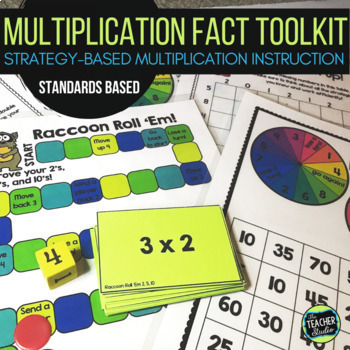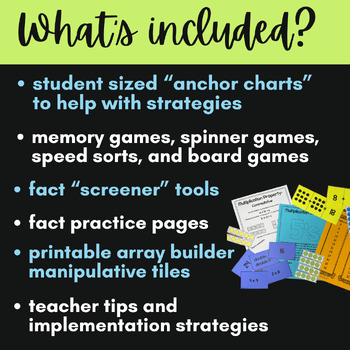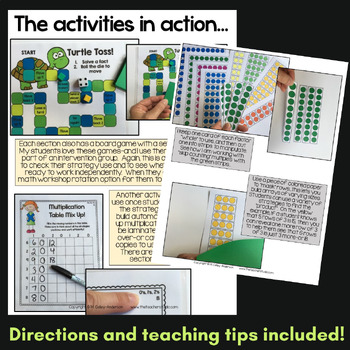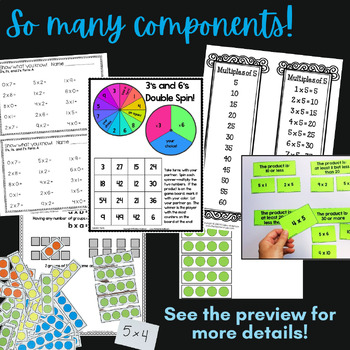Multiplication Fact Practice and Fact Fluency Activities - Multiplication Games
- PDF
What educators are saying
Description
Do your elementary students struggle to learn and remember their basic multiplication facts? Are you wanting to incorporate a research-based, strategic approach to teaching multiplication facts, but you aren't quite sure how to begin?
Let's face it. We want students to have multiplication fact fluency. We want students to be able to access their multiplication facts in their brains the same way that they retrieve basic sight words—without processing.
The way to do that is to ensure they truly understand the concept of multiplication and have learned the multiplication strategies necessary to make sense of it.
For many students, flashcards and rote memorization simply don’t work—they need to understand the patterns and relationships that are a part of multiplication facts.
This resource is full of games and activities to help you teach your students about multiplication--and to provide engaging tools to help RETEACH in intervention groups when needed!
One method that works VERY well for many students and can build into bigger number multiplication is the use of arrays; this concept is a key part of this resource.
Please note that there are array builder tiles at the beginning of this resource that are a fantastic way to build visual understanding of multiplication and the idea of “groups of”. Believe it or not, even arrays can be too abstract for some students. For some struggling students, I even put an item (a cube, a bean, etc) on each mark on the array to see that the “dot” really stands for an object. Keep that in mind if students don’t seem to be grasping the idea of “groups of”.
Many people teach multiplication facts in “order”…start with the 0’s and move to the 12’s. This resource helps students see relationships so it groups multiplication facts in ways that promote teaching in strategic ways—not just memorization. It makes sense to teach 5’s and 10’s together because they are connected. Similarly, 2’s and 4’s and 8’s group well together.
This resource is meant to provide a variety of multiplication fact activities that are NOT fill-in-the-blank worksheets to support strategy instruction to be used whole class as a part of instruction or in small intervention groups to build skills. These activities are easy to prepare and perfect to use as teaching tools and then later to build fluency through repeated practice.
Whether this practice happens in a math workshop, with an intervention group, or even sent home for additional practice, everything is easy to print and prepare and can be used over and over.
What is included?
Each section includes (and will be found in THIS sequence). See additional pages for details about how each is used.
- Teacher tips about the strategies to teach for each section.
- “Student Anchor Charts” that can be copied and put into notebooks or folders or made bigger and displayed in class to reinforce the strategies that are taught and practiced.
- A memory game
- A “speed sort” to build automaticity and fluency
- Spinner games
- A board game
- Practice “tables” for speed and fluency
- A quick “screener” to use as an interview or paper and pencil assessment with each section. This can help you determine whether a student or small group is ready to move on. This is simply a half-sheet sampling of the facts addressed in the section. There is a form A and a form B of each.
This resource is divided into the following sections:
- The resources needed to help use arrays and skip counting to build understanding of multiples.
- Photos and teaching tips for all included activities
- A section of tips and practice activities for the 0, 1, and 2 facts.
- A section of tips and practice activities for the 2, 5, and 10 facts (all work on doubling concepts)
- A section of tips and practice activities for the 2, 4, and 8 facts (stresses doubles and halves)
- A section of tips and practice activities for 3, 6, and 9 facts
- A section of tips and practice activities for “mixed”(including the missing 7 x7) facts once instruction is complete. This section has some activities for the 11 and 12 facts.
Although there are parts of this resource that tackle the 11 and 12 facts, there are very few times where these facts are necessary in the real world, so they are downplayed in this resource.
Please make sure—especially if you are using this as an intervention resource—to move as slowly as necessary. Teach multiplication strategies. Model the strategies. Repeat the strategies until it is obvious that students understand them. THEN move to the practice activities and games to build automaticity.
There is no value in practicing inefficient multiplication strategies—so get students working strategically and THEN work to increase speed. It may take longer than you think—but you can’t rush understanding.
- - - - - - - - - - - - - - - - - - - - - - - - - - - - - - - - - - - - - - - - - - - - - - - -
Please download the preview to see a sample of what is included in each section--including actual photographs of the resource in action. I hope your students will benefit from this interactive resource the way mine have!
- - - - - - - - - - - - - - - - - - - - - - - - - - - - - - - - - - - - - - - - - - - - - - - -
Looking for more multiplication resources?
◆This innovative set of differentiated challenge cards asks students to solve multiplication problems in a totally new way!
◆Want to try some multiplication math sorts? All directions are included with photos, teaching tips, and more!
◆Need some multiplication formative assessments? See what you think!
- - - - - - - - - - - - - - - - - - - - - - - - - - - - - - - - - - - - - - - - - - - - - - - -
All rights reserved by ©The Teacher Studio. Purchase of this resource entitles the purchaser the right to reproduce the pages in limited quantities for single classroom use only. Duplication for an entire school, an entire school system, or commercial purposes is strictly forbidden without written permission from the author at fourthgradestudio@gmail.com. Additional licenses are available at a reduced price.





